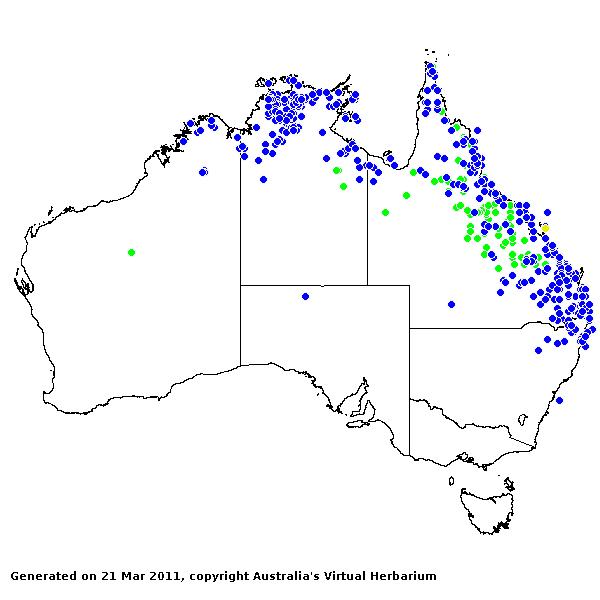Alloteropsis Presl,. Fl. Trop. Afr. 9: 487 (1919).
Derivation:.
From Greek allotrios (foreign) and opsis (appearance).
Key references
(keys and floras):. C.A.Gardner, Flora of Western Australia 1 Gramineae
230–231 (1952); J.W.Vickery, Flora of New South Wales, Gramineae 19:
81–82 (1961); E.E.Henty, Manual Grasses New Guinea 25 (1969);
J.C.Tothill and J.B.Hacker, Grasses of Southern Queensland 88–89 (1983);
R.D.Webster, Australian Paniceae 7–9 (1987); M.Lazarides, Tropical
Grasses S.E.Asia 105 (1980); T.D.Macfarlane, Flora of the Kimberley
Region 1120 (1992); B.K.Simon, Key to Australian Grasses 64 (1993);
S.W.L.Jacobs and S.M.Hastings, Flora of New South Wales 4: 455 (1993);
D.Sharp and B.K.Simon, AusGrass (2002); S.W.L.Jacobs, R.D.B.Whalley
& D.J.B.Wheeler, Grasses of New South Wales, 4th Ed, 114 (2008).
W.D.Clayton & S.A.Renvoize, Genera Graminum (1986), genus (481).
Native. 5 species, from tropical Africa, Asia and Australia. 2 species in Australia, WA, NT, Qld,
and NSW. Also New Guinea and Malesia.
Habit. Annua
(rarely) or perennial, tufted or decumbent. Leaf blades broad or narrow,
cordate or not cordate. Ligule a fringed membrane to a fringe of hairs.
Inflorescence. Inflorescence
of spicate main branches, of digitate or subdigitate racemes or spikes,
digitate or subdigitate (the branches in whorls on a short central axis).
Spikelets.
Spikelets dorsally compressed, 2 flowered, with 1 fertile floret, paired or in
triplets; with rachilla terminating in a floret, or with naked rachilla
extension (sometimes, minutely so). Fertile spikelets with lower incomplete
floret(s), lanceolate or ovate, abaxial (with lower glume on side away from
rachis), falling with glumes.
Glumes. Glumes unequal, (the upper) long relative to adjacent lemmas, hairy (upper glume
ciliate marginally), pointed, awned or awnless, dissimilar (lower glume
smaller, thinner, often mucronulate, the upper glume densely ciliate). Lower
glume 3–5 nerved. Upper glume 5 nerved.
Florets. Lower
incomplete floret(s) male. Lemmas awned or awnless, (3–)5 nerved, similar in
texture to fertile lemmas (but with a hyaline zone at the base), not becoming
indurated. Fertile florets 1. Lemmas long-attenuate, similar in texture to
glumes, smooth to striate, not becoming indurated, yellow in fruit, entire at
apex, pointed, mucronate to awned, with a clear germination flap, 5 nerved
(usually) or 1–3 nerved, glabrous, having flat margins not tucked into palea.
Awns when present, 1, apical, non-geniculate, hairless (scabrid), much shorter
than body of lemma to about as long as body of lemma. Palea relatively long,
entire, 2 nerved. Lodicules 2. Stamens 3. Grain small, compressed
dorsiventrally. Hilum short. Embryo large.
Kranz Anatomy.
C4 (in all the material examined except A. semialata subsp eckloniana)
or C3 (A. semialata subsp eckloniana), biochemical
type PCK (in Australian C4A. semialata) or NADP-ME (in some
southern African C4A. semialata).
2n = 18
(C3A. semialata) or 54 (C4A. semialata).
Habitat.
Helophytic, mesophytic, xerophytic. Marshy and weedy places. Species of open
habitats.
Classification.
Panicoideae; Andropogoneae.
Notes. A nondescript genus prone to misidentification because the untidy racemes of
awned spikelets are not immediately recognisable as panicoid. Contains species
possessing both non-kranz, PS and MS leaf anatomy. One species A. semialata has
non-kranz and PS races which cannot be distinguished with certainly from their
external morphology (Clayton and Renvoize, 1986). This situation, however, does
not exist in Australia where only PS A. semialata occurs (B.K.Simon).
Types Species. A.
distachya J.Presl. = A. semialata (R.Br.) Hitchc.
Biogeographic Element. Clifford & Simon 1981, Simon & Jacobs 1990: Old World
Tropics.


